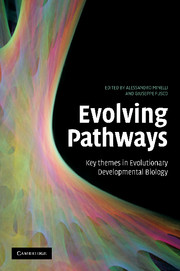Book contents
- Frontmatter
- Contents
- Contributors
- Preface
- Introduction: Pathways of change
- Part I Thinking about evolution by taking development on board
- Part II Evo-devo: methods and materials
- Part III Evolving diversity
- Part IV Evolving body features
- 17 Urbisexuality: the evolution of bilaterian germ cell specification and reproductive systems
- 18 Thoughts and speculations on the ancestral arthropod segmentation pathway
- 19 Evolution of neurogenesis in arthropods
- 20 Arthropod appendages: a prime example for the evolution of morphological diversity and innovation
- 21 Ontogeny of the spiralian brain
- Index
- References
20 - Arthropod appendages: a prime example for the evolution of morphological diversity and innovation
Published online by Cambridge University Press: 08 August 2009
- Frontmatter
- Contents
- Contributors
- Preface
- Introduction: Pathways of change
- Part I Thinking about evolution by taking development on board
- Part II Evo-devo: methods and materials
- Part III Evolving diversity
- Part IV Evolving body features
- 17 Urbisexuality: the evolution of bilaterian germ cell specification and reproductive systems
- 18 Thoughts and speculations on the ancestral arthropod segmentation pathway
- 19 Evolution of neurogenesis in arthropods
- 20 Arthropod appendages: a prime example for the evolution of morphological diversity and innovation
- 21 Ontogeny of the spiralian brain
- Index
- References
Summary
The morphology of the appendages of the arthropods has been adapted to a large number of life styles that is virtually unparalleled in any other organ in the Metazoa. Different appendage types exist e.g. for walking, swimming, jumping, prey-capture, chewing, biting, mating, egg-laying, breathing in air, fresh water and salt water, and sensory perception (see Figure 20.1 for examples). Very specialised appendage types exist for specialised modes of life: for example, the spinnerets in spiders, brush legs for the distribution of pheromones (e.g. some moths) or stings for defence (e.g. bees and wasps). In many cases, appendages from a single segment or from several segments unite and form an entirely new structure capable of tapping into new resources, e.g. the labium of insects, formed by the fusion of an appendage pair, or the proboscis of ticks, mosquitoes and flies, all of which are composed of the appendages of at least two head segments.
A number of different appendage types can be present on a single individual. The number of different appendage types and their specific morphology depend on the species' life style, but in most cases at least three different types are present: appendages for sensory perception, feeding and locomotion (Figure 20.1).
The appendages of the arthropods thus have been a prime target of adaptive evolution. They are unparalleled in their sheer number of novel forms and functions. Therefore, they are an excellent model for the study of the principles of adaptive evolution and morphological change and innovation.
- Type
- Chapter
- Information
- Evolving PathwaysKey Themes in Evolutionary Developmental Biology, pp. 381 - 398Publisher: Cambridge University PressPrint publication year: 2008
References
- 7
- Cited by



